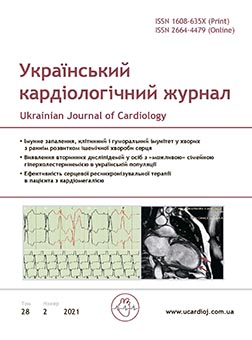Detection of secondary dyslipidemia among people with «possible» familial hypercholesterolemia in Ukrainian population
Main Article Content
Abstract
The aim – to optimize the diagnosis of familial hypercholesterolemia (FH) in Ukraine and determine the prevalence of secondary dyslipidemia among people with «possible» FH.
Materials and methods. The work was carried out in two stages of population research. At the I stage (2009–2013), in 81 out of 1000 respondents (8.1 %) the level of LDL-C ≥ 5 mmol/l was registered. At the II stage (2019), additional survey of respondents was conducted to identify secondary dyslipidemia.
Results and discussion. After additional examination of respondents with «possible» FH on II stage, type 2 diabetes was diagnosed in 20.4 %, hypothyroidism – in 14.3 %, class II–III obesity – in 16.3 %. In 30.6 % of respondents, the understudied comorbid pathology was not detected, and the level of LDL-C decreased on the background of lifestyle modification and statin therapy. The «possible» FH was finally verified in 9 patients with a burdened anamnesis of early coronary artery disease in them and/or their first-degree relatives, as well as with an increased LDL-C and total cholesterol levels on II stage, despite statin therapy.
Conclusions. The percent of respondents with «possible» FH on the I stage, based only on criteria of LDL-C ³ 5 mmol/l, was 8.1 %. But after the detection of secondary dyslipidemia, the prevalence of verified FH within urban population was 0.9 %. In the rest cases (80 %), the elevated level of LDL-C was associated with comorbid pathology. The study proves the need for further optimization of the managment of patients with impaired lipid profile to verify primary and secondary hypercholesterolemia.
Article Details
Keywords:
References
Коваленко В.М., Корнацький В.М. Проблеми здоров’я і тривалості життя в сучасних умовах.– К.: СПД ФО «Коломіцин В.Ю», 2017.– 222 c.
Коваленко В.М., Лутай М.І., Сіренко Ю.М. та ін. Серцево-судинні захворювання. Класифікація, стандарти діагностики та лікування.– К.: Моріон, 2019.– 222 с.
Митченко Е.И., Мамедов М.Н., Колесник Т.В., Деев А.Д. Современный профиль факторов риска сердечно-сосудистых заболеваний в городской популяции Украины // Укр. кардіол. журн.– 2013.– Додаток № 4.– С. 76–83.
Мітченко О.І., Романов В.Ю., Гвоздик М.В. Ранні маркери атеросклерозу та серцево-судинний ризик у жінок із гіпертонічною хворобою на тлі гіпотиреозу // Ендокринологія.– 2017.– Т. 22, № 1.– С 10–17.
Mach F., Baigent C., Catapano A.L. et al. ESC Scientific Document Group, 2019 ESC/EAS Guidelines for the management of dyslipidaemias: lipid modification to reduce cardiovascular risk: The Task Force for the management of dyslipidaemias of the European Society of Cardiology (ESC) and European Atherosclerosis Society (EAS) // Eur. Heart J.– 2020.– Vol. 41 (1).– P. 111–188. doi: 10.1093/eurheartj/ehz455.
Rosenson R.S., Freeman M.W., Gersh B.J., Rind D.M. Secondary сauses of dyslipidemia // UpToDate, Waltham, MA. (Consultado el 4 de octubre de 2015).
Ross D.S. Lipid abnormalities in thyroid disease // Uptodate.– 2020.
Sharifi M., Futema M., Nair D., Steve E. Humphries. Polygenic Hypercholesterolemia and Cardiovascular Disease Risk // Curr. Cardiol. Rep.– 2019.– Vol. 21(6).– P. 43. doi: https://doi.org/10.1007/s11886-019-1130-z.
Stevens C., Freiberger T., Akram A. et al. Overview of the current status of familial hypercholesterolaemia care in over 60 countries – The EAS Familial Hypercholesterolaemia Studies Collaboration (FHSC) // Atherosclerosis.– 2018.– Vol. 277.– P. 234–255. doi: https://doi.org/10.1016/j.atherosclerosis.2018.08.051.
Vodnala D., Rubenfire M., Brook R.D. Secondary causes of dyslipidemia // Amer. J. Cardiol.– 2012.– Vol. 110 (6).– P. 823–825. doi: https://doi.org/10.1016/j.amjcard.2012.04.062.


